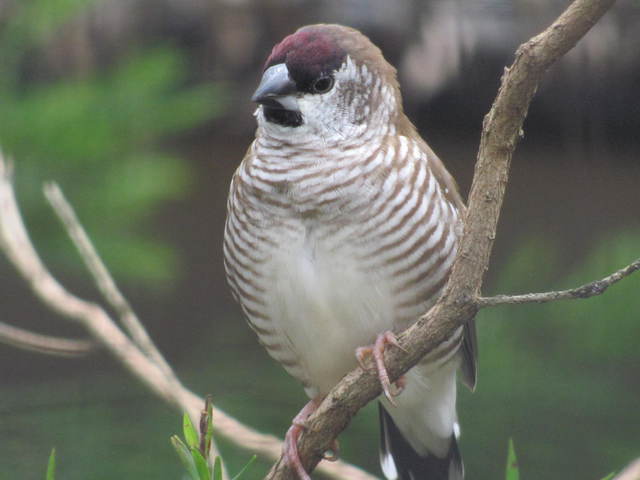The Cherry Finch is not as brightly coloured as most of the other Australian finches and this is reflected in some of its other common names i.e. Modest Finch and Plain Coloured Finch, another name is the Plum Headed Finch.
 Although not common along the coastal regions, the Cherry Finch occurs in eastern to the mid west of New South Wales, but not as far as Victoria. It extends north-wards into Queensland almost as far as Cape York. The Cherry Finch has one of the smallest area of distribution of all Australian Finches, only the Red Eared Firetail Finch and the Beautiful Firetail appear to have a less extensive range. There are no sub species recorded.
Although not common along the coastal regions, the Cherry Finch occurs in eastern to the mid west of New South Wales, but not as far as Victoria. It extends north-wards into Queensland almost as far as Cape York. The Cherry Finch has one of the smallest area of distribution of all Australian Finches, only the Red Eared Firetail Finch and the Beautiful Firetail appear to have a less extensive range. There are no sub species recorded.
Although it has only a small distribution area the Cherry Finch is not common and they are usually seen in pairs and occasionally in small flocks in the breeding season, always close to water which they visit frequently. Out of the breeding season they have been known to gather in much larger flocks up to several hundred strong. Pair bonding is very strong both in aviary and the wild where pairs tend to stay together all year long. Body contact, such as preening is rare and only occurs with partners in a bonded pair.
Please note, Livestock can naturally differ from each other as they are not always identical. These birds are now available in a variety of different colors. They may also differ from the images shown online. Customers may however, specify any of the requirements / likes / dislikes, if they have any. Availability of any specific color is not guaranteed. But we shall try to match as close as possible.
Livestock in store is health guaranteed. However, we cannot provide any life warranty after these pets are put and kept in any of our uncontrolled environment. It is important to provide a proper habitat by following some suggested tips. More information can also be obtained from specialized animal care staff at the time of purchase.
Highly Pedigreed
Bred in Free Flight Aviary
Raised only on Hari Approved Products
Kept in UVA, UVB and Infrared Nocturnal Lighting.
Care Guide and Recommendations
Habitat
- A Roomy Cage (WIdth; a minimum of double time and a half of the size of bird, when they stretch thier wings. (i.e. 18″ x 18″)
- Bedding (Fresh ‘n’ Comfy Recycled Paper Bedding, Corn cob or Paper towel with grate )
- Food Bowl (Usually included in Cages)
- Water Bowl (Usually included in Cages)
- Hideout (Tent / hammock) makes them feel protected.
- Toys (They love to chew and play, therefore, providing a few toys helps in catering to a healthy lifestyle for the pet!)
Diet Plan
- At present eating a mixture of Finch gourmet seed and small pallets.
- Pellets No colorful, sugary stuff (Preferable: Tropican Pellets; designed to create a mess free environment)
- Prime vitamin (Prime is a full-spectrum vitamin, mineral, amino acid supplement for birds. It is the only bird food supplement specifically formulated for seed, vegetable and fruit-based diets.)
- Mineral / Salt Block
- Cuttlefish bone.
- Spinach, Romain Lettuce, Kale, Berries, grapes etc.
- Treats
Lighting
UVB enables birds to produce vitamin D, also known as the “sunshine vitamin,” which is essential for calcium metabolism and immune function. UVC is normally filtered out by the earth's ozone layer and does not exist on the planet naturally.
UVB plays a very important role. It allows your bird to synthesise Vitamin D3 in their skin or through a special process involving the preening gland. Parrots need Vitamin D3 to metabolise calcium which they use to produce eggs, build and maintain strong bones and maintain normal growth.
Keeping your bird under right amount of UVB needs some consultation with a Certified Professional.
Despite other benefits from UVB, it helps processing the calcuim in captivity and help improving the birds vision.



